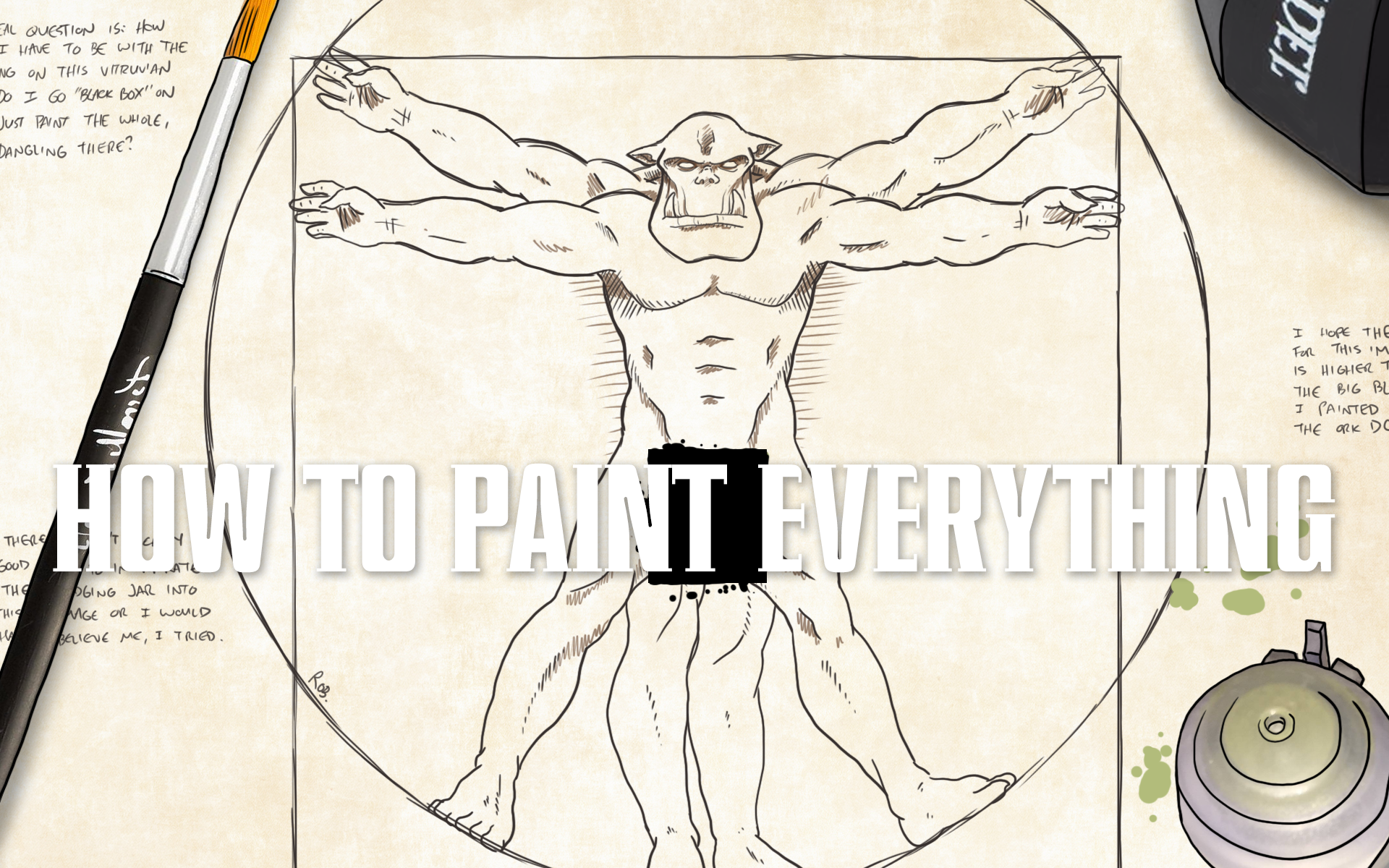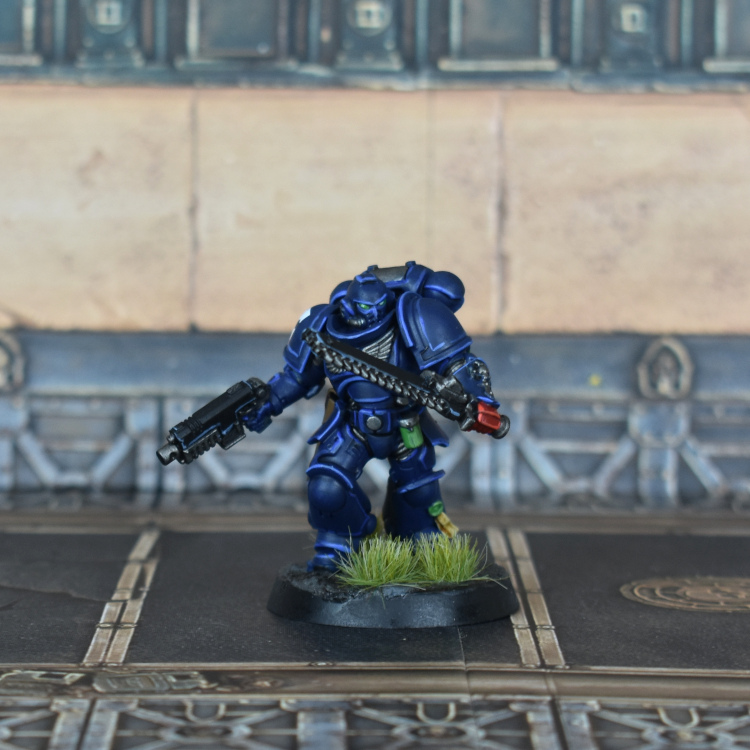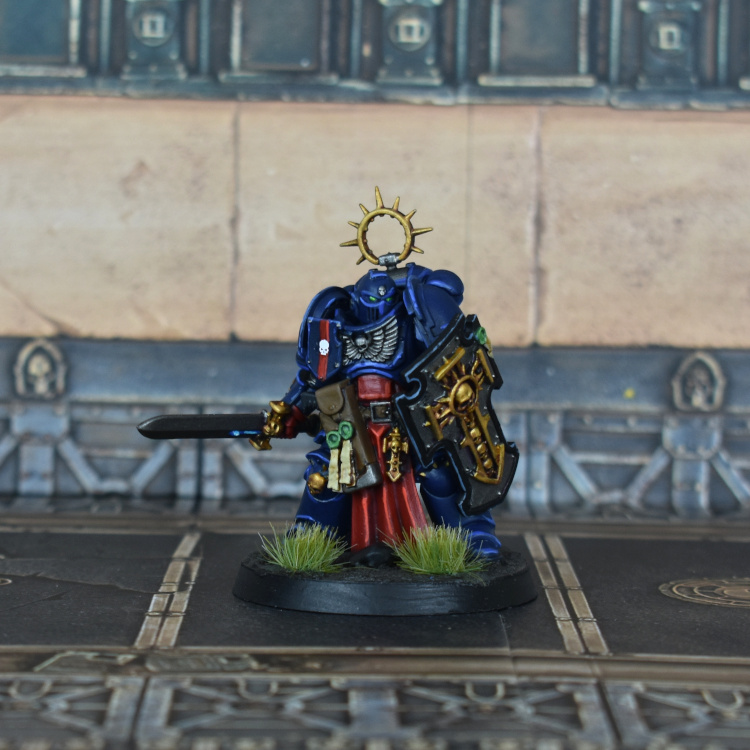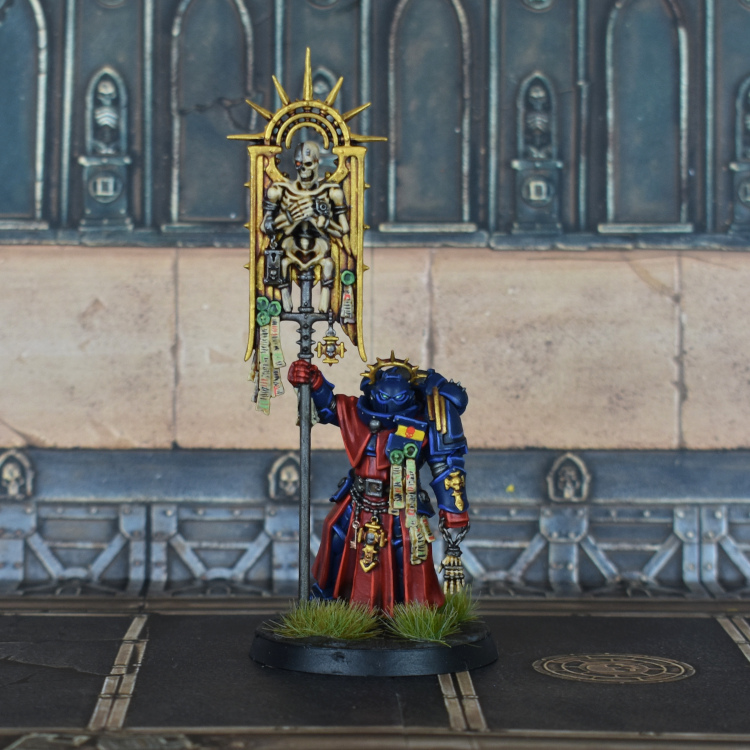In our How to Paint Everything series, we take a look at different armies of the Warhammer universe, examine their history and heraldry, and look at several different methods for painting them. With the recent release of the Indomitus boxed set, we’re looking at the two factions involved and how to approach painting them. Today, we’re looking at the new Space Marines!
The Indomitus box is packed full of new miniatures for both the Space Marines and Necrons. On the Marine side, there’s 24 new models – the bulk of them are the new Assault Intercessors, but there’s five different characters in there including the brand new Bladeguard Ancient and Judiciar, as well as new spins on the Primaris Captain, Primaris Lieutenant, and Primaris Chaplain. Along with these we also have three brand new units in the shape of the Outriders and their truly enormous bases, the Bladeguard Veterans, and the Eradicators. Unlike the Shadowspear box last year which was all about the Vanguard Space Marines, these are a mix of different model types, with both Tacticus and Gravis armour, new bikers, and a lot of the more old-school Space Marine aesthetic that was somewhat absent from other parts of the Primaris range – it’s all robes and chains and weird hourglasses here. With such variety in the box, there’s a lot to talk about in terms of different approaches. Luckily Liam, Jack, and Raf have been hard at work on their review copies, kindly provided by Games Workshop, and now they’re here to talk about them!
Liam’s Method
In our round-up last week of our Indomitus progress, I talked about the way Jack and I had split up the contents to try and make sure we covered all bases early doors – making sure that we had plenty of the new models to feature on the site! We’ve now happily reached the point where Goonhammer has at least one painted example of everything in the box, giving us both some freedom to paint, well, everything else. This box is stuffed with great sculpts and everything has been a real pleasure to work on.
Most of the builds in the box are extremely simple – these are ultimately push-fit and monopose, though of course with plastic models the only thing standing between you and reposing them is a good knife and a bit of gumption. You can conceivably build the entire box without glue and have no issues, though I think the faring on the front of the bikes would suffer a bit without glue. My one other piece of build advice, as mentioned last week, is that the Bladeguard Veterans have a very simple join for the shield – the hand slides into the wrist on a pin, keeping it separate for painting and then attaching afterwards is a much smarter thing than what I did, which was paint them fully assembled.
In terms of painting, about half the box is fairly standard for Space Marines – the Intercessors, Eradicators, and the Outrider bikes. Speaking of keeping things separate, it’s not a bad idea to attach the bikes to their bases after you’ve done the basing – they have the new-style hex pins front and back and will easily attach on later.
Other than that, the way I painted them is the same as all my other Crimson Fists, as per one of our very earliest HTPEs and extracted below for convenience:
- Prime black
- Two layers of Kantor Blue on the armour
- One layer of Khorne Red and then another layer of Mephiston Red on the red bits (left gauntlet, shoulderpad)
- Leadbelcher basecoat then Ironbreaker layer on the metals – gun, chest eagle, and in this case the soft bits of the armour
- Rhinox Hide then Steel Legion Drab on the leather (pouches etc.)
- Purity seals in Waagh Flesh, Warboss Green, and Skarsnik Green on the wax, with the parchment being Rakarth Flesh and then Ushabti Bone
- Gun in VMC Black
- Eyes in Warpstone Glow, Moot Green, and then dotted with Gauss Blaster Green
- Astrogranite Debris on the base
Then wash as follows:
- Glaze Drakenhof Blue over the blues
- Reikland Fleshshade over the reds, and over flesh if there is any
- Nuln Oil over black and metal
- Agrax Earthshade on the base
- Seraphim Sepia on the pouches, and purity seals if there are any
Then it’s highlighting time!
- For the reds, I re-layer some Mephiston Red, then hit the edges with Wild Rider Red
- For the metals, I hit high points with Ironbreaker
- The gun gets an edge highlight of Russ Grey
- The pouches get an edge highlight of Steel Legion Drab, and seals get an edge of Ushabti Bone
That’s all nice and easy! The challenging bit comes after that – the armour. There are a lot of edges to Mk 10 power armour, never mind Gravis, so this takes a fair amount of time. My first layer of highlighting comes from hitting all the edges with Altdorf Guard Blue, and then following up with a thinner highlight of Calgar Blue. This takes forever, but it also makes the edges really sharp.
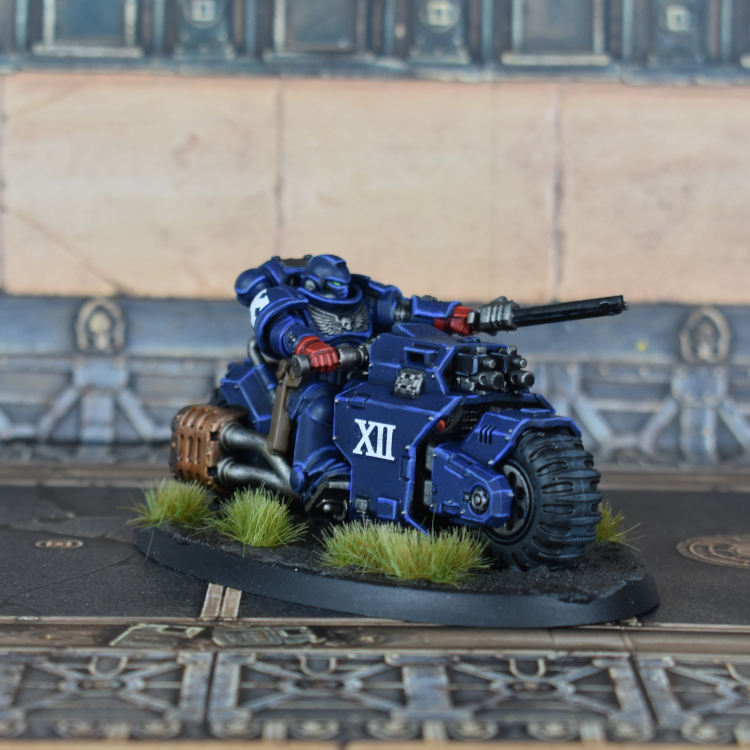
On the Eradicators, I wanted to do something a little different with their melta rifles. The barrels are painted Brass Scorpion, then Sycorax Bronze, washed Seraphim Sepia, and then some Brass Scorpion re-layered at the business end of the barrel. This is a lazy way to simulate the heat-staining effect you can see on the studio models. I did a similar thing on the engines for the Outrider’s bikes.
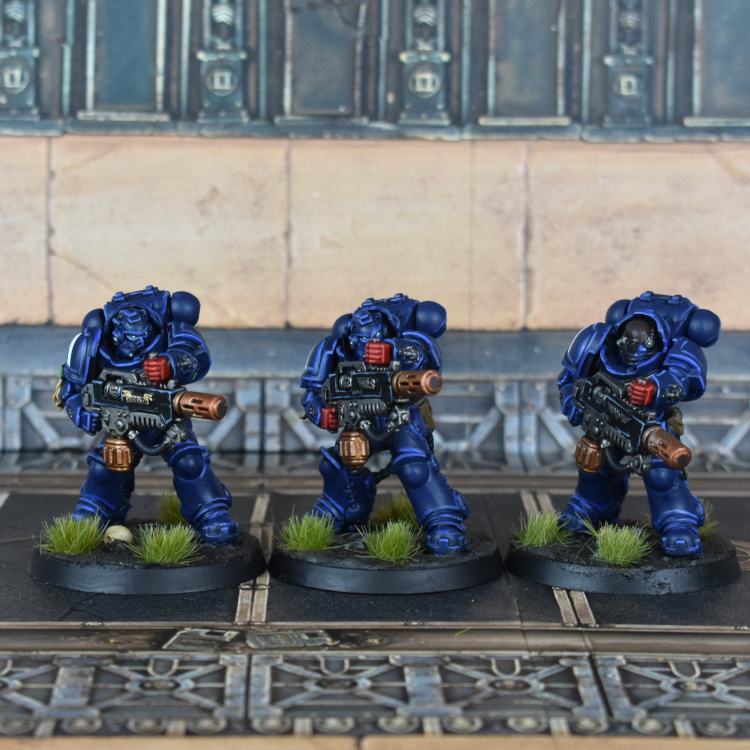
With the Bladeguard Veterans and their accompanying Ancient, we have some different considerations. First up, they have a ton of gold – for this I used a technique that Goonhammer’s own richyp told me about, where you wash it with Druchii Violet which gives it a nice depth. My regular gold is Retributor Armour -> Auric Armour, the Druchii wash, and then re-layering some Auric on top.
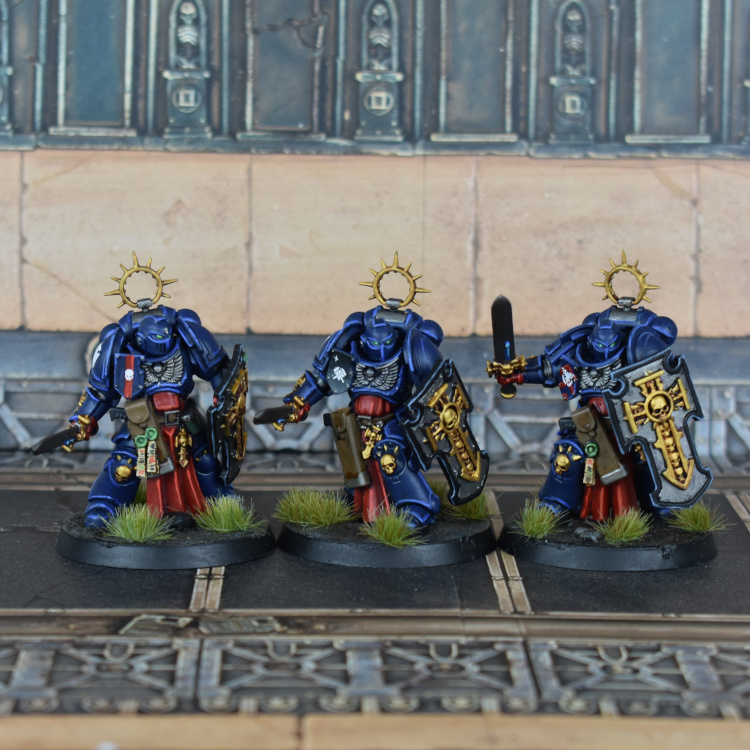
The robes are painted the same way as the red fists, and for this first Veteran I also added some heraldry to his badge in the quite simple form of a red stripe in the same colours and a skull from the Imperial Knights transfer sheet (the tiny Adeptus Titanicus version!) AT transfers are a good source for heraldry – Knights have a great variety of badges and a lot of the AT houses are unusual for 40k, so you can steal their iconography quite freely. I did the same for the other two Veterans. The shields are a fun place to play around with different things – I particularly like the Veteran with a night-sky kind of heraldry with a star at the top, and then the symbol of House Makabius re-purposed as his personal crest.
The Bladeguard Ancient is much the same as the above, just on a bigger scale – he has more robes than the others, and for his heraldry he gets a simple yellow stripe and a red skull. The banner is the same technique for the gold as described above. In the past I’ve done purity seals very simply, with just VMC Black Grey striped across for ‘text’, but after seeing a few other examples I decided to do something a bit different here and add some lines in Wild Rider Red and Skarsnik Green – this breaks them up and adds a bit extra to the, which his handy when there’s so many. Ironically, given that the Marine skeleton is, well, a skeleton, I painted the seals as above with Ushabti Bone, and the skeleton itself is Rakarth Flesh and then Flayed One Flesh.
The Chaplain is similar in execution except that the armour is, obviously, black. The main part is straight VMC Black, edge highlighted with Eshin Grey, Mechanicus Standard Grey, and then just a touch of Dawnstone. The handle of his crozius is painted the same as the purity seals, being mostly Warboss Green and then the individual diamonds edged with Skarsnik Green, which takes a bit.
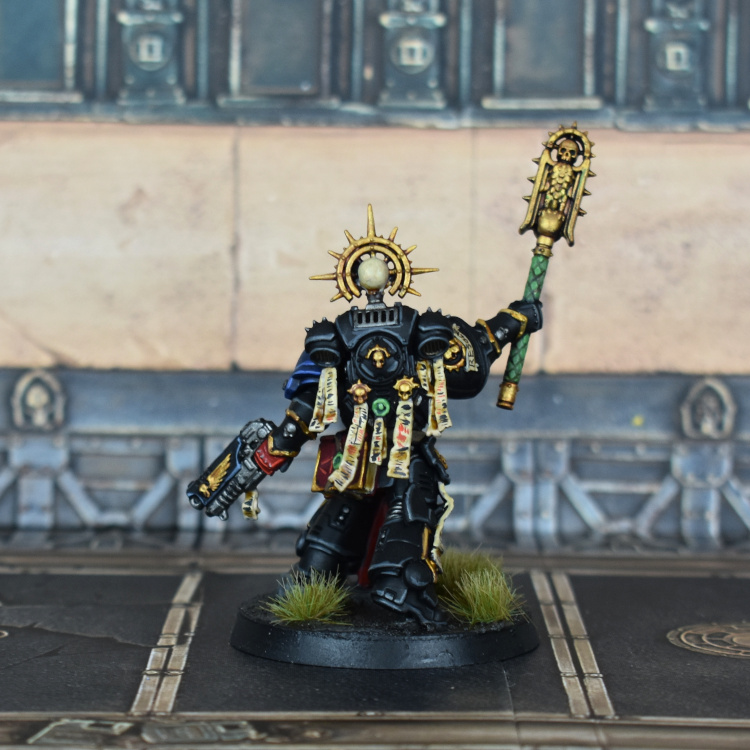
The Judiciar was painted very similarly, but he has a ton of different leathers – coat, gloves, mask – which I decided to do differently to break them up. They were all blocked in with Dryad Bark, and then the coat painted Doombull Brown, the gloves in Mournfang Brown, and the mask in Gorthor Brown. The mask and coat were washed Seraphim Sepia while the gloves were done in Agrax. I then highlighted them initially with the base colour, and then with thin highlights of Steel Legion Drab on the edges to sharpen them a bit and separate out the different materials.
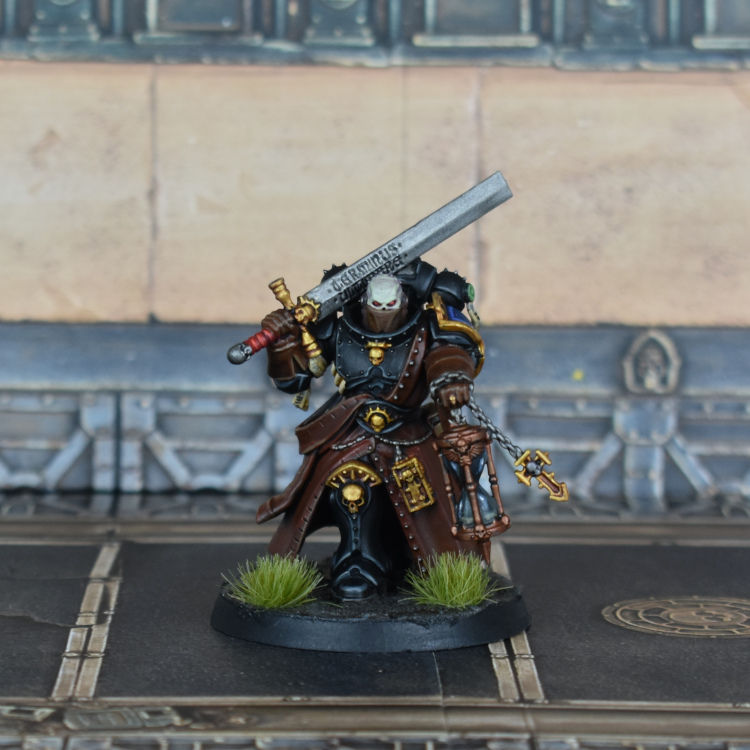
I also got a chance to use a colour I rarely try out, Balthasar Gold, which I used for the metals on the hourglass and as the base for the ring on the hand holding it (which then got some Auric Armour on top). For the hourglass itself I painted it in with VMC Black Grey initially, and painted in the glass effect, blocking in bits of Russ Grey, then some Dawnstone, and then just a touch of white as well. For the sand I used Zandri Dust, sketchily applied around the bottom of the glass. The helmet is done similarly to my Genestealer Cults Acolytes, with Ionrach Skin washed Druchii Violet and then re-layered over the top.
Both the Chaplain and the Judiciar had their skeleton ribs painted the same as the skeleton on the Ancient’s banner, Rakarth Flesh and then Flayed One Flesh.
That’s as far as I’ve gotten so far – I still have some Intercessors and bikers to finish up and then the last two characters. Technique-wise I don’t expect these to be much different to any other of my Crimson Fists, though the Captain has a lot going on – I’m sure he’ll look great when he’s done, but the prospect of painting him is daunting! Happily, Jack’s done the needful there, so check out his work below.
Jack’s Method
Despite our best efforts to split everything, Liam and I did end up with a bit of overlap as there are some things in here that are just too cool not to paint. Liam hopped in and painted up a unit of Eradicators, and I painted up the Judiciar as soon as I’d finished my main commitment. Silent angry dude with a big sword is just too cool not to paint.
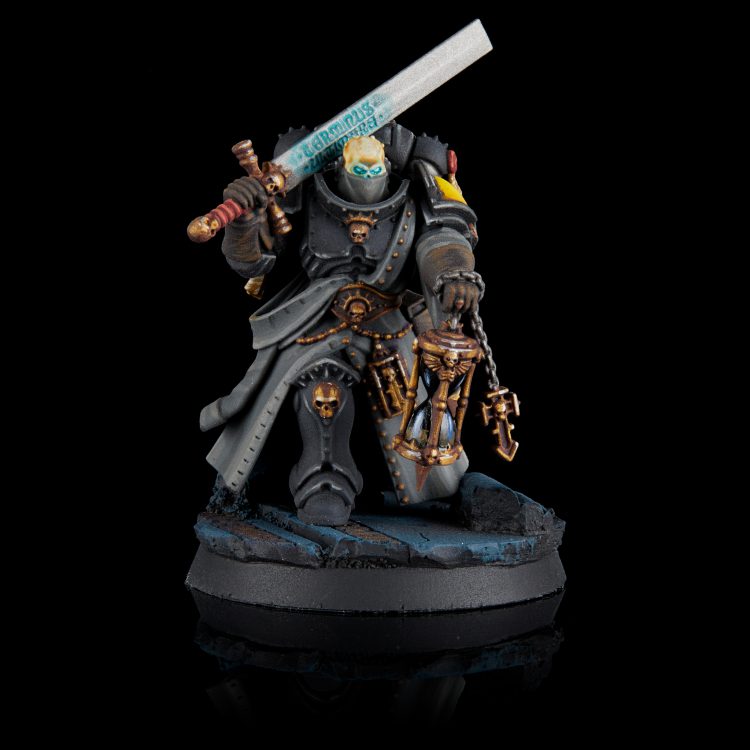
I knew this guy was going to get black armor, so I bounced over to the recipe I used in How To Paint Everything: Iron Hands. I love the richness I get in the armor from the warmer Skavenblight Dinge and Stormvermin Fur highlights, and as a bonus I knew they’d tie into the rest of the army. I’ve been using them as the primary colors for the robes on the Captain and Lieutenant I painted up from Indomitus, and on some Eliminators and Veteran Intercessors I painted up previously. I used those same colors for his coat, ending my highlights with about a 50:50 mix of Stormvermin Fur and Administratum Grey, and adding some targeted shading with Nuln Oil. I did this partly because I knew Liam was painting his at the same time and didn’t want to match, and partly I wanted to keep this silent executioner mostly monochromatic, and a brown coat would overpower it. I did paint the gloves up in a richer brown for contrast with the coat, but as a smaller area they aren’t as obvious.
His skull helmet was primed with Vallejo Desert Tan and then airbrush highlighted with a little bit of VMA Insignia White, then Skeleton Horde contrast. I went in and painted the eye sockets pure white before painting them and a little bit of the surrounding area with Aethermatic Blue contrast. The sword was painted with Iron Hands Steel, gloss varnished, washed with Nuln Oil Gloss, matte varnished, painted over with extremely thin Iron Hands Steel, and finally the letters and surrounding area also painted with Aethermatic Blue. Although it was a lot of layers, getting the wash on the sword then painting back over it let me add just a tiny tiny bit of definition to it while still retaining a primarily bright silver.
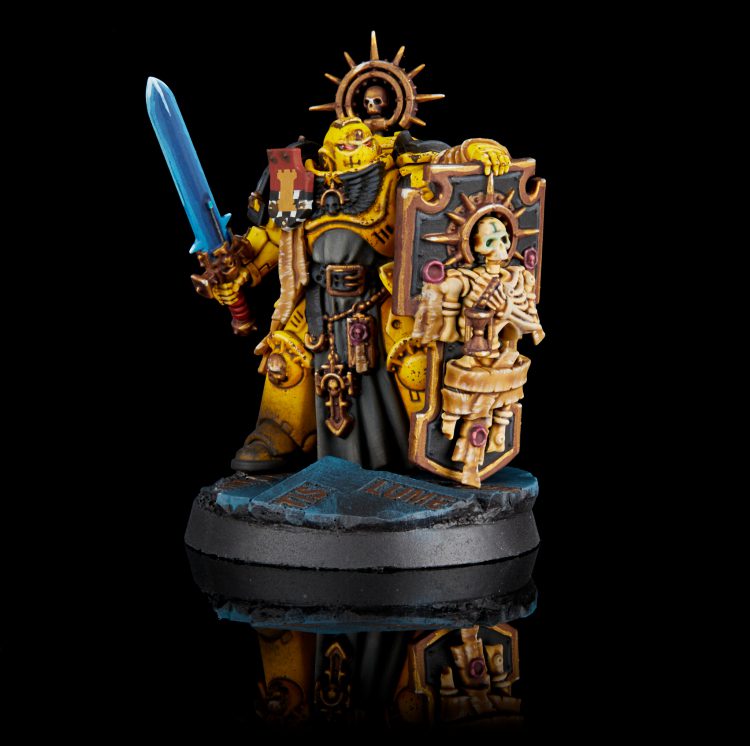
The Captain and Lieutenant were the first two things I painted out of this box. They’re incredibly detail-heavy, but beautiful models. Both of them are easy to keep their storm shields separate while painting, which I found to be incredibly important. I also keep heads and backpacks off everything as I paint it, but those aren’t quite as vital to do. I used the same set of colors as on the Judiciar’s coat to paint both their robes, though I didn’t push the highlights quite as high. They don’t get the same warm grey on areas that are painted black – I start with Scale 75 Decay Black, and highlight it with Vallejo Model Color Dark Grey and Dark Blue Grey. It ends up a little darker and a little cooler, and contrasts nicely with the yellow.
The tilting shields on both of these were painted with Word Bearers Red, black, and white, so they pull colors from across the scheme while still standing out. I painted a some simple patterns on, then tossed in decals to help tie my entire army together – I use the same castle tower decal from the FW transfer sheet across many units in my army. SRM wrote a fantastic article about heraldry to inspire painting a variety of designs on their shields.
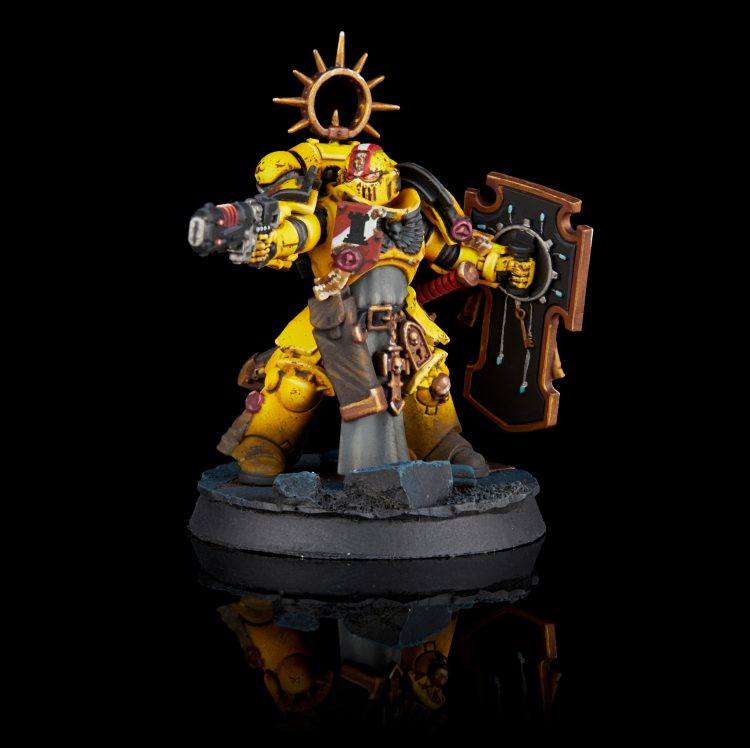
Like Liam, I’m a convert of using Druchii Violet on my golds. Bringing purple into the shadows pushes the contrast beyond what you can do with matching tones, important when there’s so much of it. I start my golds out with Scale 75 Viking Gold, wash it, then highlight first with Dwarven Gold and then on the very highest edges with Citrine Alchemy – a gold that’s so pale its hovering on the edge of being a bright warm silver. The leathers were all painted with Vallejo Model Colors German C. Black Brown, Burnt Umber, and Flat earth.
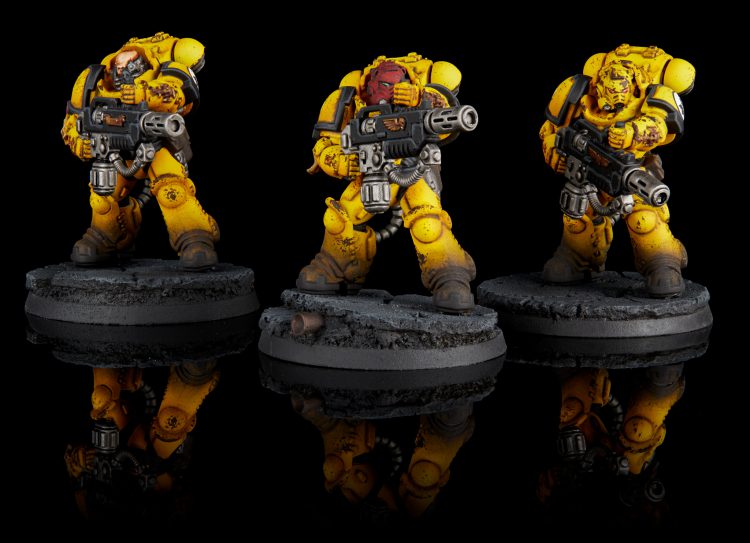
My yellow armor is painted fairly simply following a method from The Mighty Brush. I prime in tan, pre-shade with VMA Mud and Rust, add a highlight of Insignia White, then lightly airbrush layers of Medium Yellow over until I’m happy with the vibrance. I do some edge highlights with Phalanx Yellow and a pinwash of AK Paneliner for Sand and Desert to finish up the yellow, after which it gets weathered primarily by sponging Rhinox Hide.

This Blood Angel assault intercessor was painted following the same method I have in our How To Paint Everything Blood Angels article, which is the same method I used for painting the red sergeant helmet on the Eradicators. I try to match as much as possible between my different armies, so the gold, silvers, and blacks are all painted the same as on my Imperial Fists. Though I’m much less likely to do so in 9th edition than 8th it does keep my armies looking unified if I put them on the board together.

This is as far as I’ve gotten with the box. Next up from me is most likely going to be the bikes, which I’m extremely excited for as they’ll bring a nice bit of mobility into my army. At this point I’m not expecting any of the remaining models to be substantially different to what I’ve already painted up; the Bladeguard are the most complicated units remaining and I’ll be approaching them very similarly to how I painted up my Captain and Lieutenant.
Raf’s Method
I am a much slower painter than Liam and Jack so don’t have quite the progress, but I did tackle the Bladeguard Veterans and have begun on the Ancient
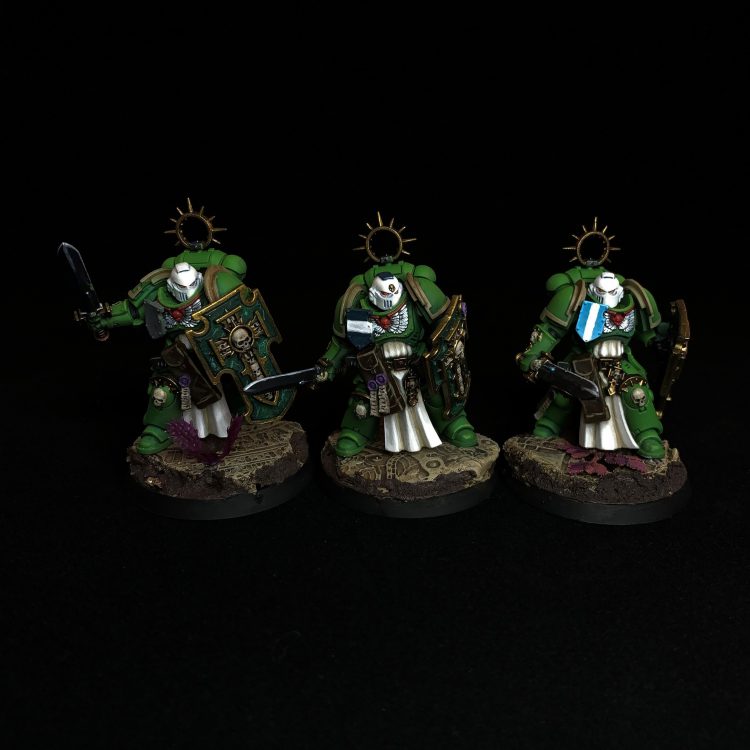
They are painted as my custom chapter, the Quetzales Jades and are packed with personal symbolism. I was born in Guatemala and am carrying various symbols and motifs through my chapter. Their main color is a bright green with teal undertones and the aquila is a two-tone white and red. This color scheme is inspired by our national bird, the Quetzal. The shields are painted to look like jade, a popular gemstone in the country and one that is important to the Mayan culture and civilization. This is echoed in the base ruins, which were made using the central gear from the board game T’zolkin—a game loosely inspired by Mayan culture. Finally, the chest heraldry is simplified versions of our national flag and the flags of various internal provinces.

The armor is done primarily with an airbrush. I primed black, then did a full undercoat of Incubi Darkness. Then I did what was effectively a zenithal highlight with Warpstone and Moot Green, followed by a final pass of cyan ink shot lightly into the shadows and recess to return some of the blue/teal to the shadows. The armor is finished with an edge highlight of 50/50 Warpstone and Vallejo Yellow, followed by a second edge of 25/75 Warpstone and Yellow.
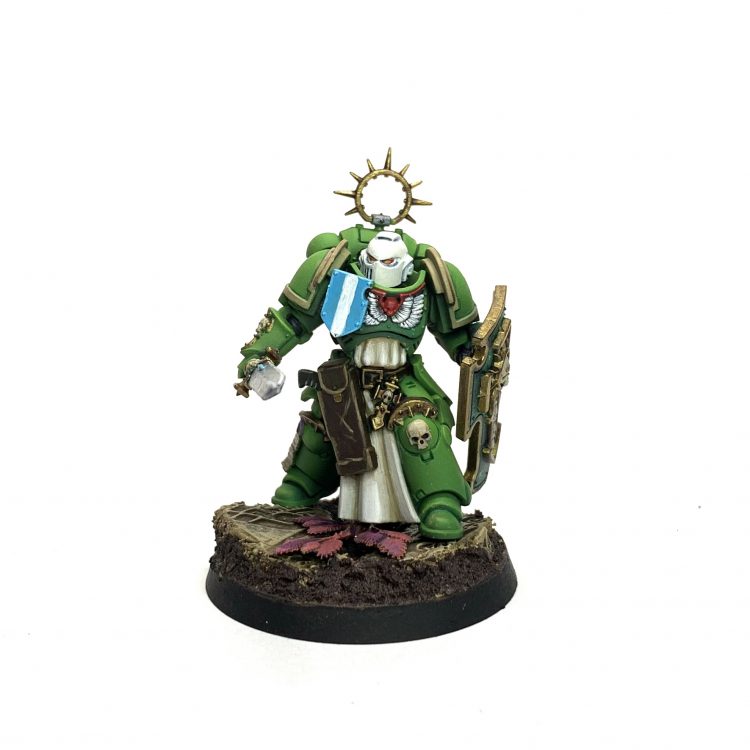
The aquila is done with Vallejo Flat Red for the top part, and 5 Scale75 Metallics Black Metal up through the silvers, ending with White Alchemy. The robes are basecoated with Zandri Dust and I work my way up to Pure White passing through Ushabiti Bone and Reaper Splintered Bone on the way. Nothing special here, just lots of layers.
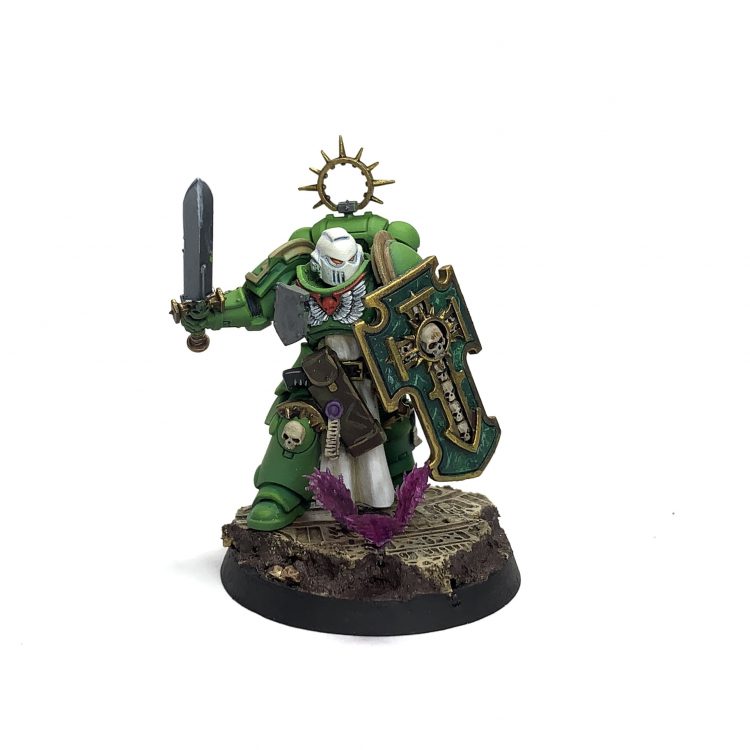
Finally, the shields were done by basecoating the inner section with Caliban Green followed by a heavy stipple of Warpstone. Reaper Jade Green was then lightly stippled, randomly to create clusters of color like you get in the gemstone. Finally the white veins were done with thinned down Splintered Bone. Scale75 Necro Gold frames the shield (and is what I used for all the rest of the gold.
The bases are stamped SuperSculpey, painted in a basic stone scheme with Stirland Mud and bits of aquarium flowers or Citadel Creeping Vines washed with Druchii Violet and Carronburg Crimson to tone down the color. The Quetzales Jades live on a deep yet alien jungle world, amidst the ruins of a still-active civilization. Not unlike modern day Guatemala. There are some custom transfers coming for a chapter logo and squad markings, and I plan to expand on their story in a later article.
Up next is the Bladeguard Ancient who has a very similar scheme to the above. I’m planning to attempt to freehand a pattern onto his robe that evokes the traditional woven textiles of Guatemala. Wish me luck…
Wrap-up
That’s it for How to Paint Everything: Indomitus Space Marines. We hope this is a helpful guide to approaching the new models in the box. As ever, if you have any questions or comments, or just want to show us your own Indomitus Marines, then hit us up at contact@goonhammer.com, on Facebook or Twitter, or in the comments. Tomorrow, we’ll be looking at the other half of the box – the Necrons!
